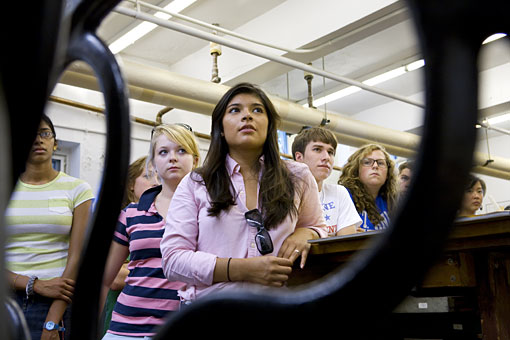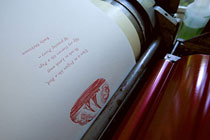ARTS AND HUMANITIES
Writing seminar explores early American literature through the original word -- and typeface
A group of Cornell students had a hands-on lesson in printing technology this fall as part of the first-year writing seminar American Literature and Culture: The Power of the Page, taught by doctoral English student Jonathon Senchyne. What they gained was a deeper understanding of the printed medium in early America.

Zoe Warhaft, center, and other students in the Power of the Page writing seminar, watch part of a demonstration in the Risley Hall print shop earlier this fall.
The course explored the cultural impact of early American printing, spanning 200 years of books, pamphlets and broadsides (such as Thomas Paine's "Common Sense") and culminating in writings by Emily Dickinson and Walt Whitman.
In September, Senchyne took his class of 12 to the print shop in Risley Hall, where they composed metal type into a familiar phrase about a fox and a dog, and ran impressions of it off a press.
"This print shop resembles more or less what you would have seen in the 19th or late 18th century," he said. "The technology has remained static for centuries."
The Caslon type in the Risley shop was once used by the New York Times, he said. Several cases of type vie for space in the shop with an automated proof press and hand-operated platen presses.
Composing type and composing an essay are not that different, Senchyne said: "The idea of 'composition' is a very interesting lens to think about our own writing and how to produce it. Even though we don't have to lay out each letter piece by piece, the work involved in making a high-quality, readable essay requires just as much forethought."
The class was assigned books on writing style and American cultural studies, and texts such as Mary Rowlandson's story of her captivity by American Indians in 1675, and "The Autobiography of Benjamin Franklin" -- who was "very famously a printer," Senchyne said. "We look at how print allows one to represent a version of oneself."

Senchyne added an engraving of a sailing ship to this poem. See larger image
Gender and social issues, like slavery and depictions of Native Americans, figured heavily in the course. In Puritan society, women like Rowlandson were not viewed as public figures. "The narrative bears the traces of her delicate negotiation of gendered expectations," Senchyne said. "In a way, she explores the boundaries of possibility for a woman's voice in public."
His students used Cornell Library's online archives, particularly the Evans collection in Early American Imprints.
Their readings included 17th-century poet Anne Bradstreet, the first woman writer published in colonial America.
"I told them to go to the online archive and find the poems in their original form," he said.
Bradstreet was not named on the cover or title page of her first book of poems. Instead, she was described as "A Gentlewoman in those parts" and "The Tenth Muse." In one poem, Bradstreet "claims to be incapable of discussing topics believed to be under the purview of men: namely, issues of state," Senchyne said -- although the title page belies that statement.
"A lot of that is lost in reading a reprinted version in a Norton anthology," Senchyne said. "Those are all important things you get from looking at forgotten elements of print such as a title page -- which scholars have been doing for years, but I'm trying to reintroduce it to the undergraduate classroom by using this approach."